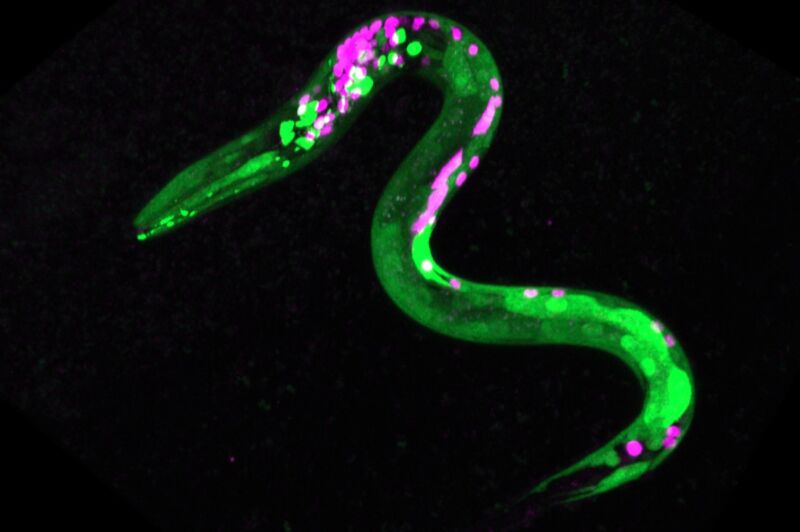
There is historical evidence that people knew as far back as 300 BCE about the ability of cannabis—which includes several different plants, such as sativa, indica, and ruderalis—to stimulate the appetite. The technical term is “hedonic amplification of feeding,” but most of us know it more colloquially as “the munchies.” Numerous scientific studies have found evidence in support of this effect. And now it seems like the humble roundworm, C. elegans, also experiences the munchies when dosed with cannabinoids, according to a new paper published in the journal Current Biology. We suspect it’s not a coincidence that the paper was released on April 20.
The worms in the experiments showed a marked preference for the roundworm equivalent of potato chips or ice cream—high-calorie junk food. “We suggest that this increase in existing preference is analogous to eating more of the foods you would crave anyway,” said co-author Shawn Lockery, a neuroscientist at the University of Oregon in Eugene. “It’s like choosing pizza versus oatmeal.”
The endocannabinoid system (ECS) regulates and controls several critical bodily functions: learning and memory, sleep, temperature control, pain control, alertness, and appetite, for instance. It’s basically a network of chemical signals and receptors running all through the brain and body. One of the most numerous receptors in the brain is called CB1, which helps control the levels and activity of neurotransmitters. The body naturally produces molecules called endocannabinoids to stimulate those CB1 receptors. There are also CB2 receptors that are mostly concentrated in the immune tissues that help keep the immune system functioning properly.
Cannabis plants have substances that bind to those same receptors, notably marijuana’s active ingredient, tetrahydrocannabinol (THC), which stimulates appetite by binding to CB1 receptors and mimicking the activity of the body’s naturally produced cannabinoids. For instance, a 2014 study with mice showed that THC significantly enhanced their ability to smell. A 2015 study identified a specific cluster of nerve cells in the hypothalamus region of the brain called pro-opiomelanocortin (POMC) neurons that were affected by cannabis. These neurons typically regulate appetite by sending “full” signals to the brain after eating, but cannabis hijacks the cells, flipping a switch so they send “hungry” signals instead.
CB1 and CB2 receptors are uniquely found in vertebrates, but most animals have receptors that could be sensitive to cannabis—after all, organisms, in general, need to regulate energy balance to survive. But there haven’t been many studies of the endocannabinoid system in animals other than rodents and primates, especially invertebrates.
Enter Lockery and his co-authors. Lockery’s lab has long focused on studying the neurobiology of C. elegans, particularly how these tiny creatures smaller than a human eyelash make decisions. The roundworms are relatively simple creatures; their genetics is well-known (and genome fully sequenced), they reproduce rapidly, and they are easily screened for any effects of potential drugs. Plus, its small but well-defined nervous system—including a functional endocannabinoid signaling system—makes C. elegans ideal for neuroscientists, like Lockery, interested in the effect of sensory inputs on motor outputs and overall behavior of the organism.
Lockery’s lab often uses food choice experiments in their research. Roundworms rely on chemotaxis to find food, using taste and smell cues. He got the idea for testing the worms’ response to cannabinoids soon after the state of Oregon legalized recreational marijuana in 2014 (with the new law taking effect in July 2015). “We thought, well, heck, let’s just try this,” said Lockery. “We thought it would be amusing if it worked.”
https://arstechnica.com/?p=1933181

